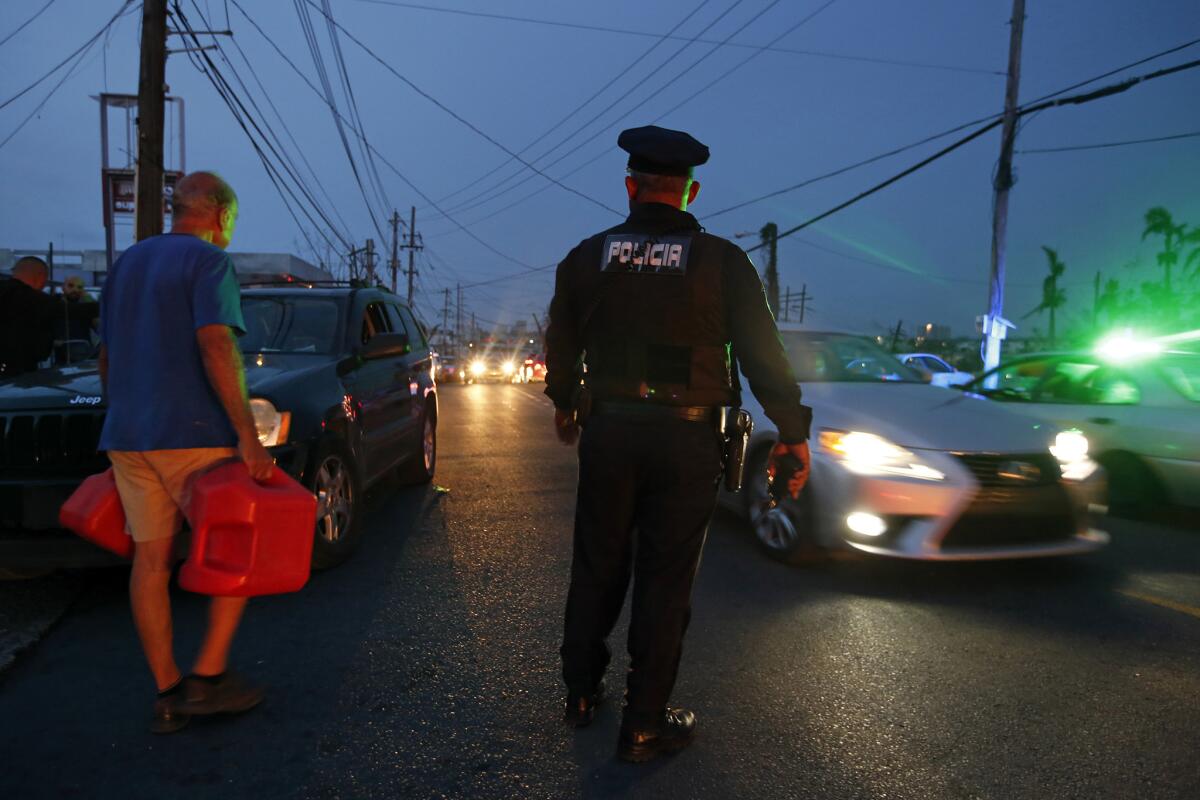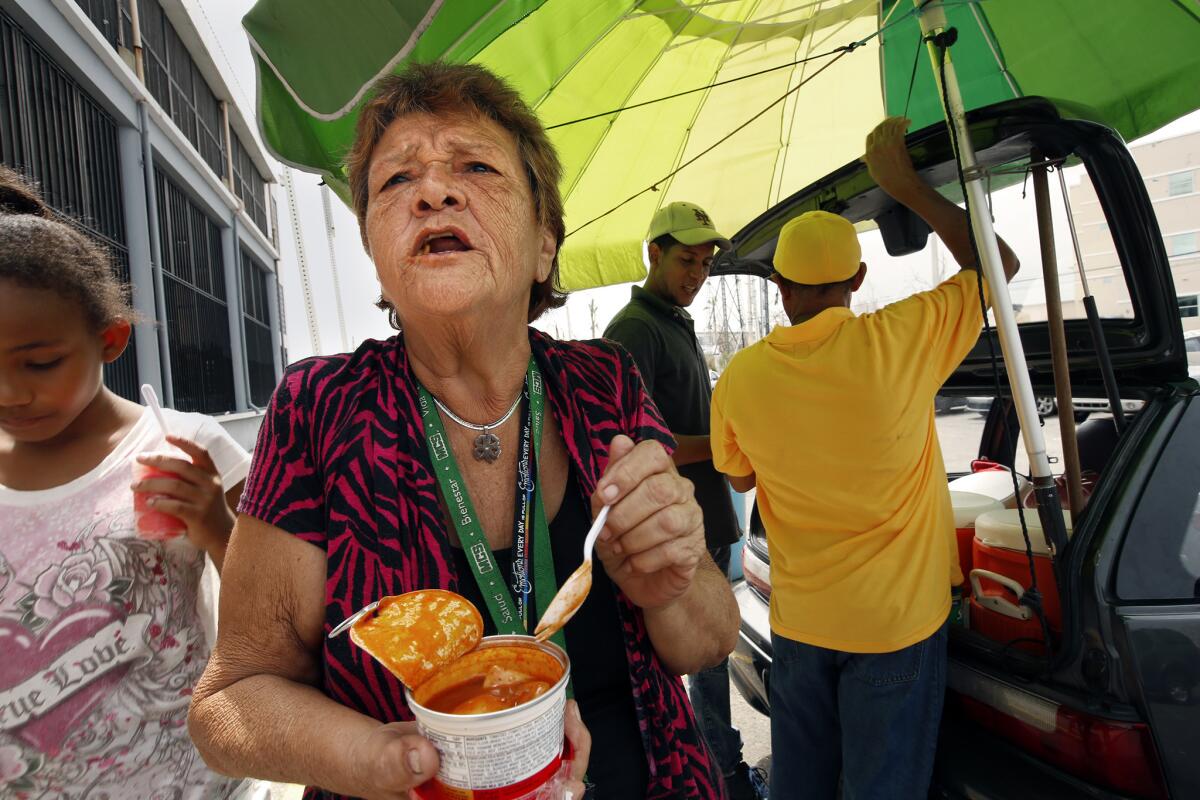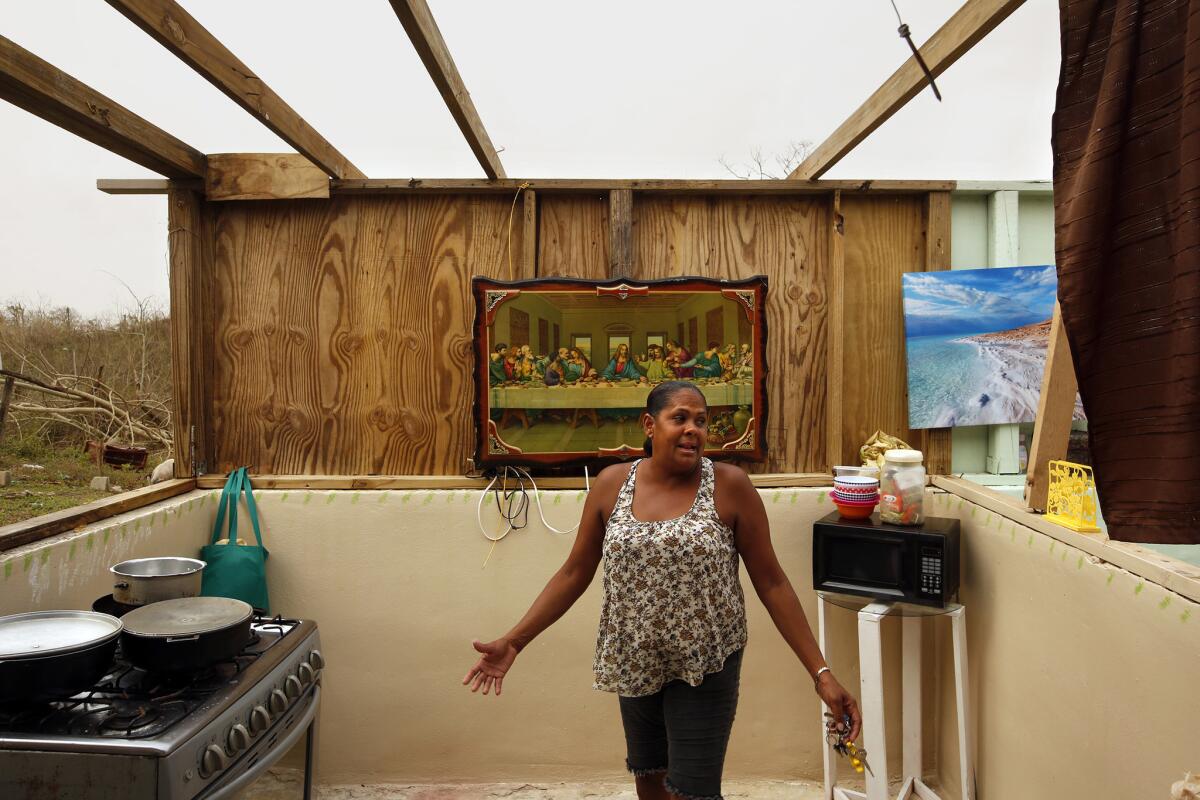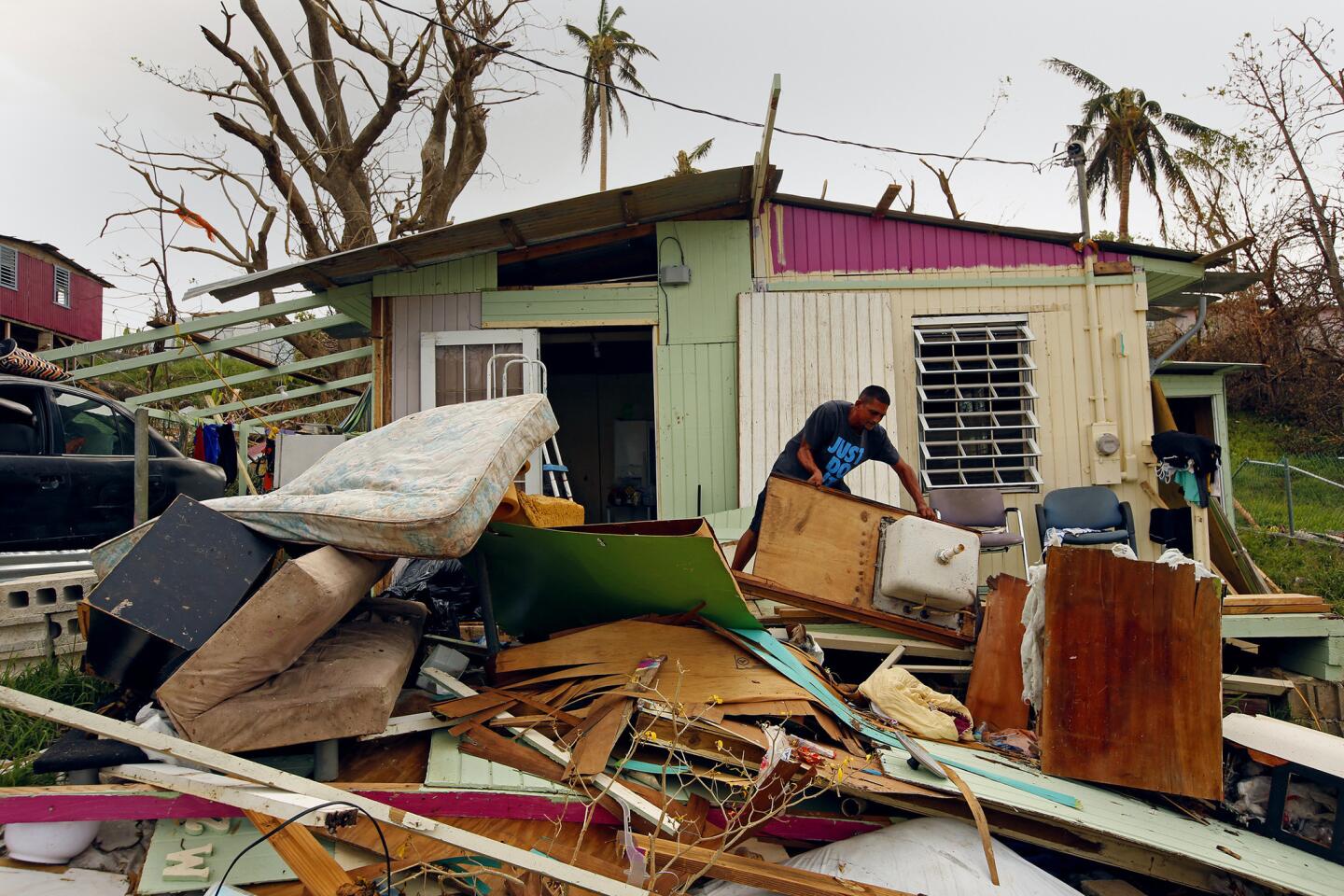So many storms: After Harvey and Irma, can a thinly stretched FEMA come through for Puerto Rico?
Reporting from San Juan, Puerto Rico — Nibbling on dwindling food stocks, lacking crucial medications, sweltering in half-wrecked homes with only tainted water for washing and barely any for drinking: For many in Puerto Rico, Hurricane Maria’s aftermath has been even more harrowing than the mighty storm itself.
Amid growing warnings of a potential humanitarian crisis in the Caribbean island territory that is home to 3.4 million U.S. citizens, federal relief efforts were ramping up Wednesday, even as criticism mounted. Among the most urgent priorities were food and water deliveries for isolated, storm-pounded rural communities and distribution of diesel for generators to power vital services such as hospital equipment and sanitation systems.
About 97% of the island’s residents still lacked power Wednesday, Gov. Ricardo Rossello said, and about half remain without running water.
On his Facebook page, Rossello posted a photo of a street intersection in the southeast coastal town of Humacao where someone had painted a huge SOS sign with the words, “Necesitamos agua/comida!” — “We need water and food.”
Increasingly desperate local officials have demanded more help from the federal government, and faster delivery of what aid is coming.
“They’re going very slowly, the aid isn’t getting to people fast enough. We seem to be losing a lot of time in jurisdictional trifles,” San Juan Mayor Carmen Yulin Cruz said in an interview Wednesday.
“People are dying,” she said. “We don’t have time for that.”
The White House has fought back hard against complaints that the federal government’s response in Puerto Rico has been less robust than in hurricane-hammered Texas and Florida.
“We’ve gotten A-pluses on Texas and on Florida,” Trump told reporters this week. “And we will also on Puerto Rico.”
Federal officials have cited logistical and geographical challenges in rushing aid to an island territory 1,000 miles from the U.S. mainland. And they have not discounted the difficulty of trying to mount simultaneous disaster operations across two states and two U.S. territories.

“I think the last 35 days have been a gut check for Americans, that we don’t have a true culture of preparedness in this country,” Federal Emergency Management Agency Administrator Brock Long told reporters.
By Wednesday, criticism of the federal effort had intensified, including some from members of Trump’s party. Sen. John McCain (R-Ariz.) tweeted that it was “unacceptable” that the Department of Homeland Security had denied a request to waive shipping restrictions to help rush fuel and supplies to Puerto Rico.
The administration argued that waiving the Jones Act, which limits shipping between coasts to U.S.-flagged vessels, would do little to ease the biggest bottleneck: damaged ports.
After back-to-back hurricanes Harvey and Irma devastated Texas and Florida, respectively, Trump was quick to chart the destruction on Twitter, and made visits to those states within days. But until Monday night, he was largely silent about Puerto Rico and the U.S. Virgin Islands, instead devoting one angry tweet after another to professional football players who kneel during the national anthem.
That contrast was pointedly noted by Puerto Rico’s supporters in Congress and elsewhere.
“Our fellow Americans’ lives are on the line,” Rep. Nydia Velazquez (D-N.Y.) tweeted at Trump on Wednesday. “Puerto Rico must receive every resource it needs to confront this crisis.”
It’s a time for a life and death decisions. The time is now...If we delay we lose.
— San Juan Mayor Carmen Yulin Cruz
Hurricane Maria, with winds just a whisper short of Category 5 status, tore through the island Sept. 20, less than two weeks after Puerto Rico was sideswiped by monster Hurricane Irma. The already faltering power grid collapsed.
Since then, relief supplies have begun to arrive at the port, but getting them where they’re needed is difficult. Unloading cranes, operating on generators, move at only half-speed. Shipping containers stuffed with disaster relief items have sat at the port because of a lack of truck drivers. The Puerto Rico Fire Department took to social media requesting licensed truck and bus drivers to come forward on Wednesday.
In the meantime, daily life has become an unceasing struggle. Banks across the island remain closed, so people are cash-strapped. A dusk-to-dawn curfew is supposed to help restore order, but people are sometimes forced to break the law as they wait in long gas lines.

Mayor Cruz said two people died because their life support was shut off when the generator at a San Juan hospital ran out of fuel.
“People in the street are doing what they can to survive,” said U.S. service member Orlando Sanchez-Matos, part of a San Juan-based military contingent getting ready to help build a shelter in the capital’s Hato Rey neighborhood.
About 1.5 million people remained without drinking water, the Pentagon said. Fifty-nine of the island’s 69 hospitals were operational, it said, but communications problems have hampered status reporting.
Hospitals, like other institutions, were using couriers to send and receive information.
San Juan’s Luis Munoz Marin International Airport and nine other airports were storm-damaged but operating, and three seaports were open as well, with five more ports in limited use, according to the Pentagon. The military said it was moving from a sea-based rescue effort to a land-based one, concentrating on route clearance and aid distribution.
In San Juan, the convention center serving as headquarters for the relief effort was abuzz with activity. Dozens waited outside to sign up for Federal Emergency Management Agency assistance. Inside, uniformed staff from FEMA, the U.S. Army Corps of Engineers, the National Guard and Department of Defense darted from room to room, coordinating aid efforts.
About 2,200 federal employees were on scene, including 500 from FEMA, officials said.
The military’s role has also deepened, with more than 70 personnel and eight HH-60 medevac Black Hawk helicopters from the Army’s 101st Airborne Division deployed to the island, the Pentagon said.
More than 2,000 active-duty U.S. service members are helping with relief efforts on the island, and the Pentagon is hoping to send thousands more troops in the coming days. Brig. Gen. Richard Kim, U.S. Army North deputy commanding general, has been named to coordinate efforts and establish a command headquarters in San Juan.
The U.S. military has opened two airfields to handle the intensified support and incoming fleets of cargo jets. The Pentagon also plans to bring in medical facilities, satellite communications equipment and a civil affairs unit from Ft. Bragg, N.C., that will be used to help boost communications with remote residents using loudspeakers, trucks, leaflets and text messaging to get information to the public.
FEMA said it has been in touch with all 78 mayors, some of whom have been issued satellite phones because most cellphone service was knocked out.

Delyris Aquino, a Puerto Rico-based FEMA spokeswoman, discusses efforts to get aid to the inhabitants of the island.
“We had a real problem with communications at first,” said Delyris Aquino, a San Juan-based FEMA spokeswoman. “Now we are getting things out.”
She also disputed any notion that the predominantly Spanish-speaking territory was being slighted in any way, saying that Puerto Rico was being given “the same amount of aid as any other territory or state.”
But one former U.S. Agency for International Development official questioned the adequacy of preparations for the massive storm.
“[Officials] saw the hurricane was going to make a direct strike, but there is a lot of aid coming into Puerto Rico now that they should have had before it hit,” said Gregory Gottlieb, who formerly served as the acting assistant administrator for humanitarian assistance at the agency.
Gottlieb also suggested that officials could do a better job of coordinating relief operations.
“There is stuff being delivered, but the challenge is getting it out. Officials still don’t have communication with some parts of the island.”
In Rio Grande, located east of Puerto Rico’s capital, FEMA food was finally being delivered for the first time in a week since the second storm left a trail of devastation on the island. People were rationing food, including mothers who were skipping meals to let their children eat. Water was dwindling and people were living in houses without roofs.
By midday, 400 families in Rio Grande had lined up to receive handouts of water and a single box of food, each containing two cans of pasta, Pop Tarts and other snacks.
When Blanca Diaz, 77, reached the front of the line, she wolfed down the cold pasta. She had not eaten in two days, she said, because she gave what food she had to her 8-year-old great-granddaughter, Kelly Calmona, who lives with her — now, at a shelter.

In Rio Grande’s impoverished Estancias del Sol, a hillside neighborhood overlooking the massive El Yunque National Forest, wooden homes lay in heaps. Families lived without roofs, bathed with pool water and watched their water tank supplies dwindle.
“We have a situation which could become an epidemic. The garbage isn’t getting picked up, people are abandoning their houses,” said Maria Cortes, a former city worker who was caring for her 85-year-old mother and disabled 49-year-old brother in a home damaged by the storm.
Cortes, 59, tried to get a tarp to cover the broken roof. City officials gave her a list of phone numbers to call. But her phone broke during the storm, and the network is down in her neighborhood, which was still without electricity and water Wednesday.

Down the street, single mother Omayra Cruz, 44, returned from the food distribution with a box she would share with 4-year-old son Nene. But the two were still living without a roof, sleeping under the stars next to a pig pen, and a picture of the Last Supper. Their water tank had a few inches left.
“We’re desperate, desperate,” she said.
Mayor Angel “Bori” Gonzalez said at least 6,000 homes in the city of 54,000 had suffered storm damage. The hospital had to close Wednesday when the generator broke, he said.
Gonzalez was lucky enough to get a satellite phone, but there was one problem, he said: FEMA officials weren’t returning his calls.
“We saw through the TV how FEMA responded immediately to Texas and immediately to Florida,” said Josue Medina, an interpreter who was accompanying the mayor on Wednesday. “They’re still taking into account what resources they need here, [and] it’s been seven days.”
Aid workers and family members anxious to help were making their way to the island as quickly as they could.
On Wednesday afternoon, a boat filled with hundreds of anxious relatives and aid workers docked in the capital, San Juan. With flights restricted, family members and aid workers had piled onto the ship, which left Miami on Monday.
“People gathered at the top of the boat when it docked and started clapping for the captain,” said Damon Taugher, director of U.S. programs for Direct Relief, a California-based humanitarian medical aid group, who was on the ship.
“There’s some anxiety about what things will look like,” he said. “But the overall mood is positive, and people are resilient.”
To read the article in Spanish, click here
»
Staff writer Vives reported from Los Angeles, staff writer Hennessy-Fiske from San Juan and staff writer Etehad from Los Angeles. Times staff writers Laura King and W.J. Hennigan contributed from Washington.
For more Southern California news, follow @latvives on Twitter.
ALSO
Postcards from an island of ruin: Puerto Rico after Hurricane Maria
In one Puerto Rico mountain town, a wall of mud came crashing down
UPDATES:
6:35 p.m.: This article was updated with additional details about the U.S. military response and an interview with a former U.S. Agency for International Development official.
5:20 p.m.: This article was updated with interviews with residents of Rio Grande and also with the mayor of San Juan.
1:40 p.m.: This article was updated with information about truck drivers, government officials and food distribution on the island.
This article was originally published at 9:45 a.m.
More to Read
Sign up for Essential California
The most important California stories and recommendations in your inbox every morning.
You may occasionally receive promotional content from the Los Angeles Times.

















